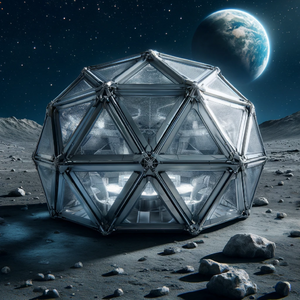
- Size
- 4.06 Meters Wide / 2.03 Meters Tall
- Occupancy
- 2 Standard / 5 Max
- Power Source
- SVR
The Oasis Adaptive Environmental Pod (called by most the Bubble) is a portable habitat composed of interlocking triangular panels, forms a polyhedral hemisphere designed for deployment on planets lacking a breathable atmosphere. Inside, the compact Spacial Variance Reactor (SVR) provides limited power for life support functions including atmospheric generation, environmental control, minimal lighting, and basic communications. The Bubble offers a modular design for rapid assembly and repair, prioritizing functionality over comfort in extreme extraterrestrial environments.
Deployment
- Site Selection
- Base Assembly
- Dome Assembly
- SVR Activation
- Comms Online
- Mission Ready
Special Capabilities
- Spacial Variance Reactor Power Source
- Low power output model that uses integrated storage cells but can be easily depleted over time
- Integrated Air Processing / Life Support
- Temperature Control / Thermal Shielding
- Thermal shielding and control can account for up to a 150 degree different (Celsius) between inside and outside temperature
- Partial Radiation Shielding
- This is limited to 15 Sv for 8 hours / 5 Sv for 16 hours
- Integrated Work Lighting
- Integrated Basic Communications
- Short range subspace communications, relies primarily on local RF frequencies, sufficient for orbital and local terrestrial communications
History
The Oasis Adaptive Environmental Pod, affectionately known as "The Bubble," stands as the culmination of years of iterative design in portable life support systems. Early iterations relied on bulky, individualized atmospheric suits that severely limited mobility and the capacity for collaborative work. Subsequent rigid habitat modules improved atmospheric containment but were logistically cumbersome, hindering rapid deployment and flexibility. The first generation of pods addressed transportability but were plagued by unreliable seals and insufficient power sources. A notable disaster, dubbed the "Fishbowl Incident," highlighted the vulnerability of earlier transparent materials to solar radiation. This catastrophe spurred advancements in material design for effective shielding. The integration of the Spacial Variance Reactor (SVR) marked a pivotal breakthrough, providing reliable power within a compact form factor. This paved the way for the current, highly refined Bubble design. Continuous improvements have focused on structural integrity, streamlined assembly, and the addition of essential life support functions like tactical lighting and secure communications channels.